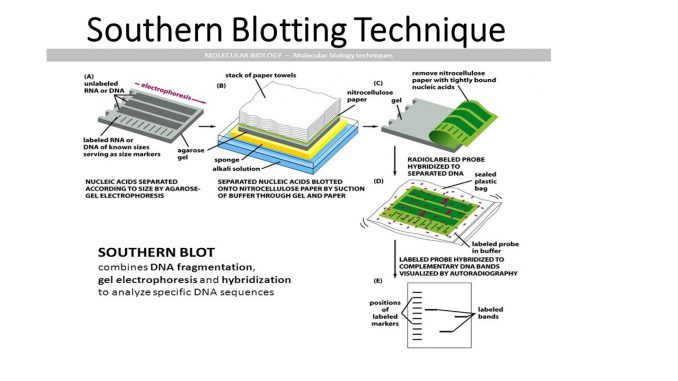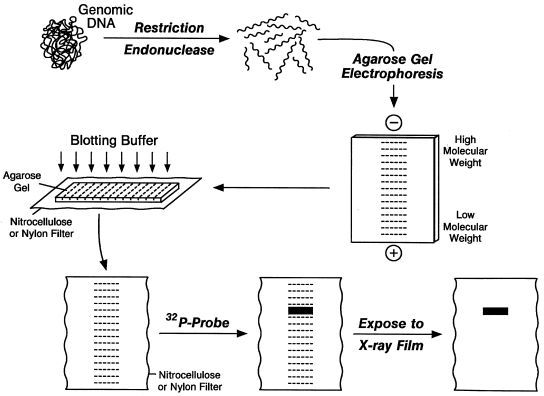
Southern Blotting
Principle:
- Southern blotting is an example of RFLP (restriction fragment length polymorphism). It was developed by Edward M. Southern (1975). Southern blotting is a hybridization technique for identification of particular size of DNA from the mixture of other similar molecules. This technique is based on the principle of separation of DNA fragments by gel electrophoresis and identified by labelled probe hybridization.
- Basically, the DNA fragments are separated on the basis of size and charge during electrophoresis. Separated DNA fragments after transferring on nylon membrane, the desired DNA is detected using specific DNA probe that is complementary to the desired DNA.
- A hybridization probe is a short (100-500bp), single stranded DNA. The probes are labeled with a marker so that they can be detected after hybridization.
Procedure/ Steps
- Restriction digest: by RE enzyme and amplification by PCR
- Gel electrophoresis: SDS gel electrophoresis
- Denaturation: Treating with HCl and NaOH
- Blotting
- Baking and Blocking with casein in BSA
- Hybridization using labelled probes
- Visualization by autoradiogram

Step I: Restriction digest
- The DNA is fragmentized by using suitable restriction enzyme. RE cuts the DNA at specific site generating fragments
- The number of fragments of DNA obtained by restriction digest is amplified by PCR
Step II: Gel electrophoresis
- The desired DNA fragments is separated by gel electrophoresis
Step III: Denaturation
- The SDS gel after electrophoresis is then soaked in alkali (NaOH) or acid (HCl) to denature the double stranded DNA fragments.
- DNA strands get separated
Step IV: Blotting
- The separated strands of DNA is then transferred to positively charged membrane nylon membrane (Nitrocellulose paper) by the process of blotting.
Step V: Baking and blocking
- After the DNA of interest bound on the membrane, it is baked on autoclave to fix in the membrane.
- The membrane is then treated with casein or Bovine serum albumin (BSA) which saturates all the binding site of membrane
Step VI: Hybridization with labelled probes
- The DNA bound to membrane is then treated with labelled probe
- The labelled probe contains the complementary sequences to the gene of interest
- The probe bind with complementary DNA on the membrane since all other non-specific binding site on the membrane has been blocked by BSA or casein.
Step VII: Visualization by Autoradiogram
- The membrane bound DNA labelled with probe can be visualized under autoradiogram which give pattern of bands.
Application of Southern blotting:
- Southern blotting technique is used to detect DNA in given sample.
- DNA finger printing is an example of southern blotting
- Used for paternity testing, criminal identification, victim identification
- To isolate and identify desire gene of interest.
- Used in restriction fragment length polymorphism
- To identify mutation or gene rearrangement in the sequence of DNA
- Used in diagnosis of disease caused by genetic defects
- Used to identify infectious agents
